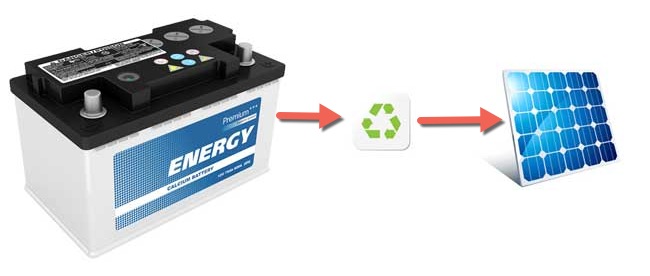
What do we do with gazillions of old, toxic car batteries? Simple. Turn them into cheap solar panels of course!
Cheap solar panels made from old car batteries?
Yup! That is the latest clean energy recycling breakthrough from researchers at the Massachusetts Institute of Technology (MIT). And the verdict at SQHQ is “GENIUS!”.
A co-authored paper published in respected journal Energy and Environmental Science describes diverting toxic waste lead material from dead car batteries and combining it with perovskite: the new wonder kid of solar power research.
The conversion has a number of advantages over silicon solar cells said MIT professor (and head of the research team) Dr. Angela M. Belcher. This included being a low temperature process and reducing the number of steps needed for conversion.
The use of perovskite as photovoltaic material has been highly effective. The compound has reached power conversion efficiency levels of 19 percent; close to that of traditional silicon solar cells. However its key drawback has been its use of lead for production, with the potential for damaging toxic residues for the environment.
According to an August 18 MIT press release though, a thin film of just half a micrometre of the recycled lead/perovskite photovoltaic material is all that’s needed for each solar cell. This means the lead taken from an average car battery could produce enough solar panels for 30 households.
Not only does this turn toxic waste into useful clean energy material but it also removes a major potential problem: what to do with the lead in old car batteries as they are made redundant by new technology such as lithium. The recycled lead is protected from leaking into the environment because it will be be encapsulated in the solar cells, according to the team.
The enthusiasm of the academic community for the research is palpable.
According to Yang Yang, a professor of materials science and engineering at the University of California at Los Angeles who was not involved in this research: “Wow, what an interesting paper, that turns the waste of one system into a valuable resource for another! I think the work demonstrated here … can resolve a major issue of industrial waste, and provide a solution for future renewable energy,” the professor was quoted as saying by MIT.
Solar power from old car batteries ticks two vitally important boxes for future generations. It reduces the serious problem of lead pollution in our environment and helps convert the noxious and dangerous waste material into a conduit for green energy. The MIT team have taken this unlikely concept and turned tomorrow’s solutions into a reality for today’s clean energy.

 RSS - Posts
RSS - Posts



And at the end of life of the new solar lead-perovskite panels how are they recycled? Just asking 🙂
Hi Alex.
Years ago I was going through a lot of old truck/bulldozer batteries to collect my solar power. Got them free, but they usually only lasted about six months (though one took 8 years to die!)
What to do with the dead ones? Too far to deliver to the recycler, so a good few mounted up. Finally, inspiration!
Get rid of the acid (lime ~ or bleach ~ will neutralise it), fill them with water and seal them thoroughly. Then they’re useable for all sorts of applications ~ like paving the floor (and building the back wall) of a giant hothouse in which I grew veggies during the winter…above the snowline. I see no reason why they can’t also be used in building an energy-efficient house; my muddy used the same principle, with concrete to absorb the daytime sun, and worked beautifully.
Using water (and lead) filled batteries would not be any less efficient (and perhaps be more so), and saves a motza in other resources…and dollars.
In fact, the plastic of batteries might be MORE durable than concrete, I suspect.
I was up there over the holidays, and, 15 years later it’s still as good as the day it was built. (and yes ~ with a bit of effort it was all Council-approved.)
I can think of other uses for expired batteries too; as should anyone with an alternative mindset. (Back when I built the place scarcely anyone had even heard of solar power ~ and most of those who had shitcanned the whole idea as hippie ratbaggery.
Now look! 🙂
oops!…Off at a tangent. But the point was that thinking outside of the box can usually provide innovative solutions.
No mention of the economics? If industry can find a cheaper source+combination process for the lead portion of those panels, then that’s what it will do. Unless the cost of disposing lead-acid batteries is high enough to tip the balance in favour of this method, in which case governments can offer that disposal cost as a subsidy to the manufacturers.
It would certainly be a neat solution.